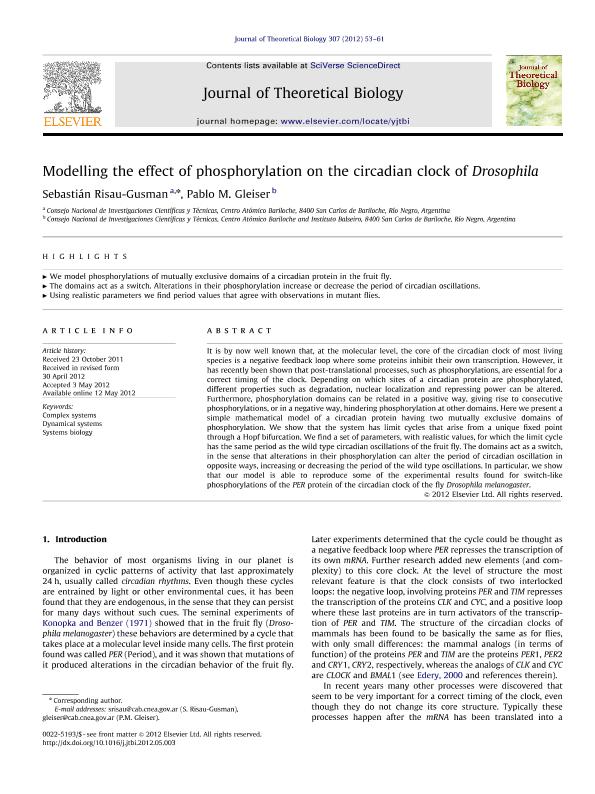Mostrar el registro sencillo del ítem
dc.contributor.author
Risau Gusman, Sebastian Luis

dc.contributor.author
Gleiser, Pablo Martin

dc.date.available
2023-03-06T15:13:27Z
dc.date.issued
2012-05
dc.identifier.citation
Risau Gusman, Sebastian Luis; Gleiser, Pablo Martin; Modelling the effect of phosphorylation on the circadian clock of Drosophila; Academic Press Ltd - Elsevier Science Ltd; Journal of Theoretical Biology; 307; 5-2012; 53-61
dc.identifier.issn
0022-5193
dc.identifier.uri
http://hdl.handle.net/11336/189686
dc.description.abstract
It is by now well known that, at the molecular level, the core of the circadian clock of most living species is a negative feedback loop where some proteins inhibit their own transcription. However, it has recently been shown that post-translational processes, such as phosphorylations, are essential for a correct timing of the clock. Depending on which sites of a circadian protein are phosphorylated, different properties such as degradation, nuclear localization and repressing power can be altered. Furthermore, phosphorylation domains can be related in a positive way, giving rise to consecutive phosphorylations, or in a negative way, hindering phosphorylation at other domains. Here we present a simple mathematical model of a circadian protein having two mutually exclusive domains of phosphorylation. We show that the system has limit cycles that arise from a unique fixed point through a Hopf bifurcation. We find a set of parameters, with realistic values, for which the limit cycle has the same period as the wild type circadian oscillations of the fruit fly. The domains act as a switch, in the sense that alterations in their phosphorylation can alter the period of circadian oscillation in opposite ways, increasing or decreasing the period of the wild type oscillations. In particular, we show that our model is able to reproduce some of the experimental results found for switch-like phosphorylations of the . PER protein of the circadian clock of the fly .
dc.format
application/pdf
dc.language.iso
eng
dc.publisher
Academic Press Ltd - Elsevier Science Ltd

dc.rights
info:eu-repo/semantics/openAccess
dc.rights.uri
https://creativecommons.org/licenses/by-nc-sa/2.5/ar/
dc.subject
COMPLEX SYSTEMS
dc.subject
DYNAMICAL SYSTEMS
dc.subject
SYSTEMS BIOLOGY
dc.subject.classification
Biología

dc.subject.classification
Ciencias Biológicas

dc.subject.classification
CIENCIAS NATURALES Y EXACTAS

dc.title
Modelling the effect of phosphorylation on the circadian clock of Drosophila
dc.type
info:eu-repo/semantics/article
dc.type
info:ar-repo/semantics/artículo
dc.type
info:eu-repo/semantics/publishedVersion
dc.date.updated
2023-03-05T15:35:46Z
dc.journal.volume
307
dc.journal.pagination
53-61
dc.journal.pais
Estados Unidos

dc.description.fil
Fil: Risau Gusman, Sebastian Luis. Consejo Nacional de Investigaciones Científicas y Técnicas. Centro Científico Tecnológico Conicet - Patagonia Norte; Argentina. Comisión Nacional de Energía Atómica. Gerencia del Área de Investigación y Aplicaciones No Nucleares. Gerencia de Física (Centro Atómico Bariloche); Argentina
dc.description.fil
Fil: Gleiser, Pablo Martin. Comisión Nacional de Energía Atómica. Gerencia del Área de Investigación y Aplicaciones No Nucleares. Gerencia de Física (Centro Atómico Bariloche); Argentina. Comisión Nacional de Energía Atómica. Gerencia del Área de Energía Nuclear. Instituto Balseiro; Argentina. Consejo Nacional de Investigaciones Científicas y Técnicas. Centro Científico Tecnológico Conicet - Patagonia Norte; Argentina
dc.journal.title
Journal of Theoretical Biology

dc.relation.alternativeid
info:eu-repo/semantics/altIdentifier/url/https://linkinghub.elsevier.com/retrieve/pii/S0022-5193(12)00228-7
dc.relation.alternativeid
info:eu-repo/semantics/altIdentifier/doi/http://dx.doi.org/10.1016/j.jtbi.2012.05.003
Archivos asociados
